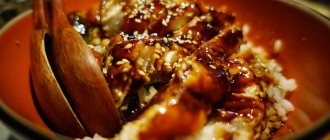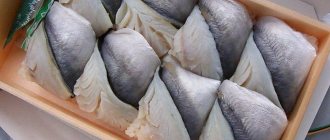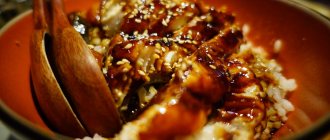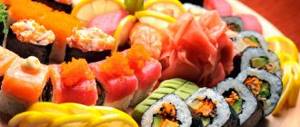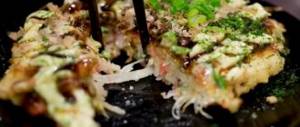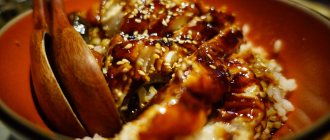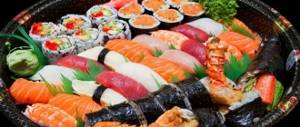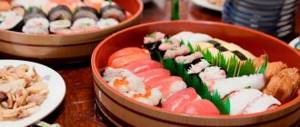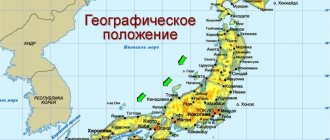Japanese fugu fish is the gastronomic equivalent of playing Russian roulette. The fish, which is quite ugly in appearance, is capable of inflating itself and exhibiting protective spines. The internal organs of fish contain tetrodotoxin, a poison whose toxicity is many times greater than that of strychnine and cyanide. A small amount of it is enough to poison a person, but each fish contains so much of it that it can lead to the death of several dozen people. The fugu dish was not served at the imperial table.
Several dozen people die from poisoning in Japan every year, mostly in remote areas where fugu is cooked by amateurs. Death occurs within a few minutes. At the same time, the best chefs prepare the delicacy in such a way that when consuming the dish, the gourmet experiences a slight tingling sensation on the lips, which can heighten the senses and allow one to feel the fragility of life.
Japanese fugu fish dish
Despite this, fugu is a popular dish. Residents of the Land of the Rising Sun consume 10,000 tons of dangerous delicacies per year. Fugu is considered a delicacy especially in winter and the main consumption occurs during the winter months. The best fugue, according to experts, comes from the outskirts of the city of Shimonoseki, which is located on the southern edge of the island of Honshu. In this city, there is a bronze monument in front of the fish market. Images of fish can also be seen on city manhole covers. Although fugu is very popular in Osaka, Tokyo is the largest center of its consumption. In Japan, the name of the fish consists of two characters meaning "river" and "pig".
The pinnacle of Japanese cuisine, fugu fish
Fugu fish is the most famous dish in Japanese cuisine. Fugu is a symbol of Japan along with geisha, samurai, ninja, sake, hara-kiri and sushi.
A special feature of the fish is the presence of tetradoxin poison in it, for which there is no antidote. The fish itself does not produce poison, but accumulates it thanks to a specific diet - food with marine bacteria, which produce tetradoxin. The largest amount of poison is contained in the liver and ovaries of fish, which is why they are not eaten. However, poison is present in microscopic doses in fish in any case.
Detailed process of preparing fugu fish // Photo by Travel Thirsty Fugu fish grown in artificial conditions is not poisonous, but is considered not authentic. And there are enough complaints about this method of growing, although it is safe.
After all, lovers of fugu fish dishes are worried about the feeling of danger. The poison present in fish leads a person to a certain ecstatic state. The labor of experienced chefs is more expensive. And dishes made from dangerous fish are much more expensive. And it’s not Japanese to be afraid of fish.
Puffer fish can only be eaten after special treatment. Also, one of the safety conditions is that fugu fish dishes are prepared by a certified chef.
The Travel Thirsty channel pleased us with a detailed story about cooking and eating fugue fish. And since the story came out, it means the author survived that evening.
Detailed process of preparing fugu fish // Photo by Travel Thirsty
Description of the sea animal
The fish itself from which this unusual dish is prepared is called rocktooth, dogfish or pufferfish. The puffer fish looks very interesting. Her skin is dark brown in color, covered with light spots. The average body length of the animal is about 30−40 cm, but you can often find representatives longer than 50 cm. Its body is not covered with scales.
Representatives of the pufferfish family feed on the following:
- algae and various protozoa;
- small fish;
- starfish.
If a pufferfish is frightened, it will instantly swell and take on a spherical shape, studded with sharp spines. Thanks to this feature, in this state its size increases three times. This scares away attacking fish. Even if the fugu is swallowed, it will swell in the animal's throat and cause its death.
A frightened puffer fish instantly swells and takes the shape of a ball studded with sharp spines.
The path of the puffer fish from the aquarium to the chef's table
That case when you are loved not for your appearance, but for your kind heart. And the dissatisfied fish is quite so cute - much better than in an aquarium.
Detailed process of preparing fugu fish // Photo by Travel Thirsty
Detailed process of preparing fugu fish // Photo by Travel Thirsty
Detailed process of preparing fugu fish // Photo by Travel Thirsty
- Fish spa - when they bite you for your money
- Sashimi - the natural taste of fish
- Penis fish - a South Korean delicacy
Consumption history
It is not known exactly when Japanese fish first appeared on the traditional menu. The most ancient artifacts have been preserved, proving that it was used as food more than 2 thousand years ago. The people of Japan are the only nation that has managed to turn a deadly product into a delicacy.
Official written sources that mention the consumption of fish date back to the 18th and 19th centuries . During the Tokugawa , deaths from eating fugu were rare because authorities issued an official ban on consumption. This decision was made after the mass poisoning of troops. The restriction was not fully observed - this species of inhabitants of the water kingdom is too familiar and loved by people. But the Japanese have become much more careful and circumspect. In those days, they began to prepare the product more carefully, more carefully, and eat less often. At the same time, new cooking methods were invented that minimized the dangers. All of them are known to modern chefs who know how to make a great dish from a deadly ingredient.
It is known that during the Tokugawa period, residents of the western regions knew best how to cook fugu safely. In these parts, the authorities were weak, so the prohibitions were observed conditionally, and it was not difficult to get ingredients.
At the end of the 19th century, a new period of Japanese history began - the Meiji Restoration. The poisonous Japanese fugu fish has again been persecuted, this time seriously. Control has been tightened, the authorities have taken control of all regions of the country. The Japanese, true to traditions and habits, violated laws, but quietly. Almost everyone knew where and how to try the forbidden fruit. The exception was the emperor: the dish seemed too dangerous for such a high-ranking person to include it on the menu.
In 1958, the rules of national cuisine changed again. A chef's license was introduced. A person who successfully completed an educational course could receive one. The system is still practiced today. The duration of training is several years. Conclusion - one exam in which the candidate first prepares a dish and then eats it himself. On average, only every third person has successful test results, since the commission is strict and the slightest mistake leads to refusal. Thus, the poisonous species of marine life turned out to be almost completely safe for customers - only impeccably trained and mastered specialists work in restaurants.
Fugu is a delicacy long banned in Japan.
Cutting fugu fish
The process of cutting fish begins when it is still alive. And this cannot be considered humane. Research confirms that fish feel pain.
Detailed process of preparing fugu fish // Photo by Travel Thirsty
Detailed process of preparing fugu fish // Photo by Travel Thirsty
Detailed process of preparing fugu fish // Photo by Travel Thirsty
Detailed process of preparing fugu fish // Photo by Travel Thirsty
Detailed process of preparing fugu fish // Photo by Travel Thirsty
Also on topic
Fugu fish or poisonous cooking of Japan
Lifestyle
Fugu fish is such a tempting and outlandish delicacy for many. This name refers to a dish made from a fish called the brown rocktooth of the pufferfish family. This representative lives mainly in the waters of Japan; it can also be found in the fresh waters of Niger, the Nile, the Amazon, and the Congo.
The brown rocktooth itself is a very small fish, 40-50 cm long, looks inconspicuous, covered with skin and small poisonous spines, has good eyesight and an excellent sense of smell for searching for food. The nostrils of the rocktooth, thanks to their atypical location - on small outgrowths - tentacles located just below the eyes - are capable of detecting the smell of food over vast distances. Fugu has developed teeth. Fugu feeds exclusively on inhabitants of the marine world - sea worms, sea urchins and stars, and various mollusks. Therefore, this species lives near the bottom, most often not falling deeper than 100 meters. When in danger, the fish inflates like a balloon.
Many scientists suggest that this fish is so poisonous because of its diet. Toxins that enter the body of the rocktooth from its diet accumulate in the tissues, especially the eggs, ovaries and liver.
In the family, the male is the leader. To create a pair, the male circles around the female, depicting a kind of dance. The newly created couple sinks to the bottom and looks for a suitable shelter for future offspring, most often this is a flat stone. After the female lays eggs, she swims away and never returns to the nest. The male fertilizes the eggs and remains until the offspring are fully mature. Until the first fry appear, the male covers the stone with the eggs with his body, and after hatching, he digs a small hole at the bottom where he transfers the offspring. The entire period until the babies begin to feed themselves, they remain under the protection of the male. However, the fish has almost no natural enemies due to its dangerous poison. Any fish that wants to attack the puffer receives a lethal dose of poison and may die.
Fugu fish sashimi
First, the fish fillets are dried with a cloth and then cut into thin strips. The pieces are eaten raw. But what is this “only after special processing”? Where is she in this case? In washing the fillets under running water? Or was it still a safe fish?
Detailed process of preparing fugu fish // Photo by Travel Thirsty
Detailed process of preparing fugu fish // Photo by Travel Thirsty
Detailed process of preparing fugu fish // Photo by Travel Thirsty
Detailed process of preparing fugu fish // Photo by Travel Thirsty
Detailed process of preparing fugu fish // Photo by Travel Thirsty
Detailed process of preparing fugu fish // Photo by Travel Thirsty
Detailed process of preparing fugu fish // Photo by Travel Thirsty
Detailed process of preparing fugu fish // Photo by Travel Thirsty
- Spicy fish soup kalchi
- The most dangerous dishes in the world
- Penis fish - a South Korean delicacy
Chef training and licensing
The metropolitan government passed the Fugue Ordinance in 1949, which introduced a licensing system for fish processors. The move was prompted by uncontrolled consumption, which led to numerous deaths from poisoning during the period of food shortages after World War II. Processing fish is a tedious task that requires great skill and precision. This license gave the right to purchase, process and sell fresh ocean puffer. According to ancient custom, a chef whose client dies from food poisoning must commit ritual suicide by seppuku.
The path to professionalism takes at least 11 years. All chefs in Tokyo who prepare fugu are licensed. All of them have undergone a basic three-year training in craftsmanship, completed specialized courses, passed a written exam and are able to demonstrate mastery of preparing a dozen types of dishes. About 900 people take the exam each year, but about two-thirds pass the test. To be fair, only 19 of Japan's 47 prefectures require licensing to become a fugu chef.
Each prefecture has its own requirements for handling fugu. In some regions, such as Kyushu, there are no restrictions on sales, allowing Tokyo residents to bypass the capital's government restrictions by ordering the fish online.
Salad with fugu fish rings fried in batter
Part of the fillet is shredded and fried in batter. Again, the moment with special processing is unclear. Is heat treatment a special thing? What about sashimi then? Or is this a professional secret that was not revealed to us?
Detailed process of preparing fugu fish // Photo by Travel Thirsty
Detailed process of preparing fugu fish // Photo by Travel Thirsty
Detailed process of preparing fugu fish // Photo by Travel Thirsty
Detailed process of preparing fugu fish // Photo by Travel Thirsty
Detailed process of preparing fugu fish // Photo by Travel Thirsty
Detailed process of preparing fugu fish // Photo by Travel Thirsty
Also on topic
Japanese hot spice wasabi
Cooking technology
To prepare fugu, the cook must follow strict rules. After removing the poisonous parts of the fish with a special knife, the carcass is cut under running water to wash off the residue. Poisonous trimmings are placed in specialized containers, which must be stored under lock and key and disposed of properly. The pulp is cut into thin slices. Some chefs say that cutting out poisonous parts is not a difficult process, but experienced chefs disagree with this statement. The deadly parts can be located in various organs and tissues depending on the type of fish.
Fugu fish soup
Well... soup is soup in Japan too. Even from deadly poisonous fish. Thinly sliced pieces are quickly boiled. Based on the experience of preparing such an experiment from ordinary fish, everything takes about five minutes.
Detailed process of preparing fugu fish // Photo by Travel Thirsty
Detailed process of preparing fugu fish // Photo by Travel Thirsty
Detailed process of preparing fugu fish // Photo by Travel Thirsty
Detailed process of preparing fugu fish // Photo by Travel Thirsty
Also on topic
Japanese cuisine: Wagyu beef dishes
Mortality from poisoning
Every year, about 20 Japanese are poisoned by this fish, for some the poisoning is fatal. There were 14 poisonings recorded between 2002 and 2006. Three died in 2003, two in 2000. In 1997, the death rate was higher, with six out of eight poisoned people dying. In 2009, six Japanese people were poisoned by eating a dish prepared by an unlicensed chef. The statistics from the mid-twentieth century are much worse. In 1950, 400 people died, and more than 31 thousand of those poisoned survived. According to research, about 60 percent of those who taste poorly cooked fish go to the next world. Between 1974 and 1984, 200 people died after eating home-cooked fish livers.
Most poisonings and deaths are attributed to the “efforts” of amateur cooks who try to cut fish without undergoing special training. After a few minutes, a general feeling of malaise is felt, and death, depending on the dose of poison ingested, occurs within a period of time from 6 hours to 24 hours. Paralysis spreads throughout the body, while the victim remains conscious. Death occurs from respiratory failure after the onset of convulsions. Although the mind remains clear, the arms and legs become numb, it becomes impossible to sit, the ability to speak and move is lost, and soon breathing stops. In Japan, they delay the funeral for several days, in the hope that the victim will wake up.
In January 1975, Bando Mitshugoro, the legendary kabuki actor, died after asking a Kyoto restaurateur to cook him four servings of fugu liver. He enjoyed the tingling sensation on his tongue and cheeks, but death was not long in coming. The actor died eight hours later.
Ready-made fugu fish dishes on the table
Dishes prepared from fugu fish. The author of the material did not eat some of the sashimi raw and lightly boiled the pieces in boiling soup.
Detailed process of preparing fugu fish // Photo by Travel Thirsty
Detailed process of preparing fugu fish // Photo by Travel Thirsty
Detailed process of preparing fugu fish // Photo by Travel Thirsty
Detailed process of preparing fugu fish // Photo by Travel Thirsty
Detailed process of preparing fugu fish // Photo by Travel Thirsty
Detailed process of preparing fugu fish // Photo by Travel Thirsty
Detailed process of preparing fugu fish // Photo by Travel Thirsty
Detailed process of preparing fugu fish // Photo by Travel Thirsty
Detailed process of preparing fugu fish // Photo by Travel Thirsty
Asian World, Life & Notes on MirSerpen.Ru
✈️ Travel services
Where does it live?
The habitat of the puffer fish is diverse; it is a low-boreal Asian species, found in all subtropical waters. The fish is found in the Sea of Okhotsk, Yellow, East China and Japan, in the waters of Lake Chad, in the Nile, Amazon, Congo, and Niger rivers. In summer it can be found even in the local Russian part of the Pacific Ocean.
The most poisonous ones prefer to live off the coast of the Pacific and Indian Oceans. Fish spawn in the spring, mainly in a quiet place, at about 20 meters deep, gradually sinking to the bottom lower and lower with age, or changing their habitat further into the open seas or on the coast. Large species prefer to choose a habitat at a depth of 80-100 meters, they live near the bottom, and fry can be seen at the mouths of brackish rivers, they like to swim in quiet currents, their favorite places are in the area of sea bays and calm waters.
Fish also choose to move in schools in shallow water with a sandy, loose bottom, thus protecting themselves from various types of predators and hunters. They do this due to the large number of different types of aquatic vegetation and the bottom topography and reefs. The fugu does not have the ability to move at high speed; its round shape, which does not have any special aerodynamic characteristics, does not allow it to do this, so it can rarely be found in the water column. She moves sideways and backwards, even backwards.
Fugu is non-migratory, but as it develops it prefers to move further and further into the sea. During storms and floods, the puffer comes closer to the coast and hides. There are no recorded cases of fish attacking people, and all such photographs on the Internet are fake.
Dinner in the name of death
The owner of a restaurant that aspires to have fugu dishes on its menu is required to provide detailed reports to the sanitary inspectors of the Ministry of Health on the quantity and storage conditions of stocks of this fish in his establishment. Cutting a pufferfish is a unique art that takes a long time to learn, and only a few master it. Back in 1598, a law appeared obliging a cook who wants to cook this fish to obtain a state license. In order to enter the circle of the elite, you must pass two exams - written and practical. Approximately three-quarters of applicants are eliminated in the first test, which requires an understanding of dozens of varieties of fugu and knowledge of all detoxification methods. And during the final exam, the candidate must eat what he himself prepared.
It is not surprising that prices for such delicacies range from $100 to $500 per serving. One of the most famous fugu dishes is fugusashi. Mother-of-pearl slices of raw fish are arranged in petals on a round dish. Often the chef creates a real picture from the pieces: landscapes with butterflies or a flying bird. The fish is eaten by dipping the slices in a mixture of ponzu (vinegar sauce), asatsuki (crushed chives), momiji-oroshi (grated daikon radish) and red pepper. As a rule, customers who come to specialty restaurants order only fugu. The meal begins with fugusashi, followed by fugu-zosui - a soup made from pufferfish broth decorated with rice and a raw egg, as well as lightly fried slices of the same fish. The fugu pieces are served by the chef in a strictly defined order. They start from the back - the most delicious and least poisonous, then approach the peritoneum - the place of the main accumulation of poison. The cook's duty is to vigilantly monitor the condition of the guests, not allowing them to eat more than a safe dose. To do this, it is necessary not only to know the intricacies of preparing this dish, but also to have medical knowledge, since the intensity of the effects of the poison depends on the client’s build, temperament and even skin color.
[edit]Also
- The pufferfish named Puffy is the mascot of the Orthodox OS OpenBSD.
- Puffer fish is also a ball fish.
- Tetrodotoxin is believed to be a component of a potion used by Voodoo sorcerers to create zombies. In STALKER, tetrodotoxin mixed with a pound of some kind of rubbish is an “experimental remedy” for not
turning into a zombie during the ejection, but simply sleeping through it.
two and a half kilograms eaten within 48 hours, if the child does not burst and the ass won't stick together. However, in the 90s, young squash-lovers ate “Inspiration” for their dear souls, if the family had easy money
)
.

